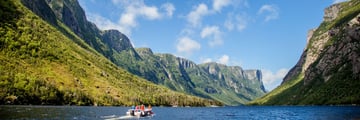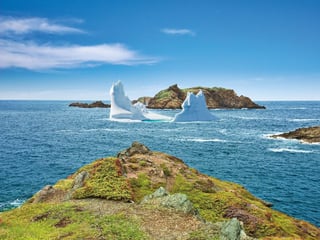Top 10 things to do in Newfoundland and Labrador
t’s all rainbow-coloured wooden houses clinging to cliffsides, hike-worthy landscapes, and outstanding national parks in Canada's easternmost (and youngest) province of Newfoundland and Labrador. Add to the mix historic towns and villages, 11,000 miles of craggy coastline, and a rich Viking history, and it’s easy to see the appeal of this wanderer’s paradise. Here are the top 10 things to do in the place known as “The Rock.”

#10
Fall in love with the atmospheric village of Cupids
It’s been over 400 years since Bristol-born merchant and adventurer John Guy established Cupers Cove (now known as Cupids) as England's first colony in Canada, but it still draws the camera-clicking crowds. Located in the heart of Conception Bay on Newfoundland’s east coast, this tiny 761-strong community is a must-do for history lovers; not least for its Cupids Cove Plantation Provincial Historic Site that has archaeologists revealing more artifacts about the lives of Guy and his 39 colonists on every summer dig. Further must-dos include hitting the incredible seascape hiking trails at Spectacle Head and Burnt Head, watching a Shakespearean play at the open-air Perchance Theatre, and admiring the John Guy monument built in 1910 to commemorate Cupid’s 300th anniversary. Also visit the Cupids Legacy Centre for its state-of-the-art exhibits, archaeology lab, and lovely rooftop Faerie Garden that overlooks the harbour.

#9
Whales, Bergs and Birds
Each spring and summer, Newfoundland offers one of the most dramatic natural spectacles in North America - the seasonal convergence of whales, icebergs, and seabirds.
Up to 22 species of whale, including humpbacks, minke, fin, and the occasional orca, migrate to these rich feeding grounds to gorge on capelin and krill. The humpback whale is particularly iconic here, known for its acrobatic breaches and tail slaps, which are often visible from both land and boat. The waters off Newfoundland, especially along the Avalon Peninsula and around Trinity and Bonavista Bays, provide exceptional opportunities for whale watching, with sightings peaking from June to August.
Just as the whales arrive, so too do the icebergs. Carried south from Greenland by the Labrador Current, these ancient frozen giants travel what is known as "Iceberg Alley", a corridor stretching from the Labrador coast to the northeast coast of Newfoundland. May and June are the best months to spot these massive sculptures of ice. Some of these icebergs are estimated to be over 10,000 years old, and their slow passage past coastal towns like Twillingate and St. Anthony provides a serene and awe-inspiring contrast to the lively energy of the whales. But their presence is less predictable than the whales so a sighting is a nice bonus to a wildlife watching tour.
Above this marine drama, the skies teem with birds. Newfoundland is a birdwatcher’s paradise, home to millions of seabirds that nest along its craggy cliffs and offshore islands. Puffins, with their colourful beaks and comical waddles, are perhaps the best loved. The Witless Bay Ecological Reserve boasts North America’s largest Atlantic puffin colony, while Cape St. Mary’s Ecological Reserve hosts tens of thousands of gannets, kittiwakes, and murres.
Together, the whales, bergs, and birds form a seasonal trinity that defines Newfoundland’s coastal identity, offering an unparalleled wildlife experience.

#8
Visit the Beothuk Interpretation Centre at Boyd's Cove
Founded in 1981 during a survey to locate Beothuk sites, this 300-year-old treasure was once home to the Newfoundland’s aboriginal people - the last of whom died in 1829. Located at the bottom of a bay in Boyd's Cove on the island’s northeast coast, the site has a narrow beach, a freshwater stream, and a mile-long hiking trail that leads to the village. Highlights include the outline of distinctive house pits (the only evidence of the Beothuk people’s homes), the reconstructions of a smokehouse, storage pit and burial site, and the Spirit of the Beothuk - a bronze statue designed by the late Newfoundland artist Gerald Squires. At the interpretation centre you’ll find plenty of exhibits and artifacts relating to this now-vanished culture, most interestingly a detailed diorama, a replica canoe, a 20-minute film about the archaeological dig, and a viewing deck. The site is open from mid-May to mid-October.

#7
Spend time in the provincial capital of St. John’s
Set on the eastern tip of the Newfoundland’s Avalon Peninsula overlooking a sheltered harbour, the oldest and most easterly city in North America charms with big-city sophistication and a refreshing small-town vibe. Must-dos include touring the towering Basilica-Cathedral of St. John the Baptist, watching artists and craftspeople at work in the Quidi Vidi Village Plantation, and admiring avant-garde sculptures and ancient weaponry in the Rooms - an impressive cultural complex that houses the province’s main historical museum, art gallery, and archives. Further thrills include watching a St. John's IceCaps hockey game at the Mile One Centre, browsing the high-end boutiques on Water Street, and kicking back with a cold beer at one of the many bars, clubs and live music venues on George Street - the undisputed star of Newfoundland's buzzy Entertainment District that’s nicknamed “The Biggest Little Street In North America”.
What looks like a higgledy-piggledy cluster of rainbow-coloured houses haphazardly wedged into the precipitous rock face is The Battery - a small community set at the entrance to the harbour in Newfoundland and Labrador’s provincial capital of St. John's. Built as temporary accommodation after the devastating Great Fire of 1892, these Victorian terraces (brilliantly nicknamed “Jellybean Row”) provide permanent residences for those who fancied living in a historic dwelling painted in eye-poppingly bright hues. Given this harbourfront neighbourhood is located at the base of the iconic Signal Hill (the very spot where Marconi famously received his first wireless transmission in 1901), a good hike is very much in order. Most popular is the mile-long North Head Walking Trail that connects The Battery with Cabot Tower. It takes around two hours and rewards with epic views of the rugged Atlantic Ocean as you embark on the 500-foot descent.

#6
Discover whaling history at Red Bay National Historic Site
Designated a World Heritage Site by UNESCO in 2013, the fog-shrouded fishing village of Red Bay on the coast of Labrador is where you’ll find plenty of stories of how thousands of Basque whalers came to these waters to hunt large numbers of right and bowhead whales (they were then rendered into oil for export to Europe). Highlights include standing at the burial ground where 140 whalers were laid to rest, taking a boat or kayak to Saddle Island to marvel at archaeological sites and check out the remains of the 16th-century Basque whaling station that was discovered in the 1970's, and hunt for Captain Kidd’s treasure that’s buried somewhere near a “pond on a hill.” Also noteworthy is the interpretation centre where the scene-stealer is an eight-metre chalupa used by whalers on the ocean to harpoon their giant catch (it’s the oldest known whaling boat in the world). The site opens from early June to the end of September.

#5
Learn about lighthouse life on Cape Bonavista
Built in 1843 and in operation until 1962, the iconic red-and-white striped lighthouse on a headland of dark-grey rock at Newfoundland’s Cape Bonavista is one of the few left on the planet where you can still climb up the stone tower to see the same seal oil fuelled light used in the 19th century. Used to mark the entrances to Bonavista and Trinity bays and to aid mariners headed for Labrador, this two-story frame dwelling (now as a provincial museum) houses an in-depth exhibition about lighthouse life. Most fascinating is the famous catoptric lighting apparatus transferred from the Inchcape (or Bell Rock) Lighthouse in Scotland, and the interpretive displays that detail the history of the lighthouse and its keepers. You’ll also get the lowdown on Irishman Jeremiah White - the lighthouse’s very first keeper who lived here with his wife and four children until his death in 1876 (his sons continued to tend the light until 1895).

#4
Learn about Inuit culture at Torngat Mountains National Park
Named for the Inuktitut word for “place of spirits,” the Torngat Mountains are the highest in mainland Canada east of the Rockies. Reached only by charter plane or boat from Goose Bay, Nain or Kangiqsualujjuaq, they are best explored on a guided tour with the elders and youth from Nunatsiavut and Nunavik who call this place home. There’s fjords, valleys and towering peaks galore, as well as plenty of wildlife (seals, whales, wolves, eagles, caribou, muskoxen, polar and black bears). Unsurprisingly, it appeals most to adventurers on wilderness camping excursions - many of whom tend to stay at the Inuit-staffed Torngat Mountains Base Camp (open from July to September) at Happy Valley-Goose Bay. Mercurial weather aside, must-dos include scouring the ground for remains of tent rings, stone caribou fences, food caches and graves, taking a boat trip to spot turquoise-outlined icebergs, and steering well clear of the ever-present polar bears.

#3
Go back to Viking times at L'Anse aux Meadows National Historic Site
A UNESCO World Heritage Site since 1978, the windswept coastal outpost of L’Anse aux Meadows where Norse sailors first settled in North America has clung onto its title as the only authenticated Viking site on the continent. Located at the edge of Newfoundland's Great Northern Peninsula, it features a waterside settlement with eight timber-and-sod buildings, three replica buildings with costumed Viking-playing actors, and a three-kilometre trail that winds through the barren landscape. There’s also a superb interpretive centre where you can watch a film about Norwegian explorer and Viking champion Helge Ingstad who followed a hunch (and an ancient map) to rediscover the site in the 1960’s. Be sure to visit the recreated Viking port of trade nearby to play traditional Norse games, take pottery lessons, and marvel at the Norse knarr replica of Snorri - the first ocean-going Viking merchant ship that sailed here from Greenland (it was supposedly named for the first Viking child born in North America).

#2
Become an honorary Newfoundlander at a ‘screech-in’ ceremony
The only way to become an honorary Newfie (member of Newfoundland) is to get ‘screeched-in’ at an optional ceremony that involves a shot of screech (Newfoundland rum), a short recitation of a few words in olde-worlde English, and the kissing of a cod on the lips. This bizarre ritual (strictly a Newfoundland thing for non-Newfoundlanders who are known as "Come From Away" or CFA’s) is commonly performed in town pubs - most famously the ones found along the buzzy George Street in St. John’s. If you fancy giving this a go, head to The Screech Room housed in the Masonic Temple - the 112-year-old architectural gem location on the capital’s Cathedral Street. Here you can get the lowdown on screech history though photos, maps and stories, sit down for a delicious meal, and sample some screech-themed drinks. The Screech Room opens daily for ‘screech-ins’ and also hosts a happy hour on Thursday and Friday from 4:30pm to 6:30pm.

#1
Hike and climb at Gros Morne National Park
Designated a World Heritage Site in 1987, this supersized Lord of the Rings-like playground in western Newfoundland is where geologists proved some of the world’s best examples of the process of plate tectonics. It’s also where adventurous types come to traverse the moon-like Tablelands, sharpen their kayaking skills on the Trout River, and leg it up to the top of Gros Morne Mountain for great views of Bonne Bay and Ten Mile Pond. Further must-dos include venturing through the billion-year-old Western Brook Pond Fjord on a two-hour cruise that takes in the 1,150-foot-high Pissing Mare Falls and the cliffside sculpture known as The Tin Man. The park is also home to Writers at Woody Point - an annual literary festival that mixes author readings with musical performances at Woody Point Heritage Theatre and at other intimate venues in the heart of Gros Morne National Park (this year’s festival runs from 15 to 20 August).

More Inspiration
Recommended holidays












